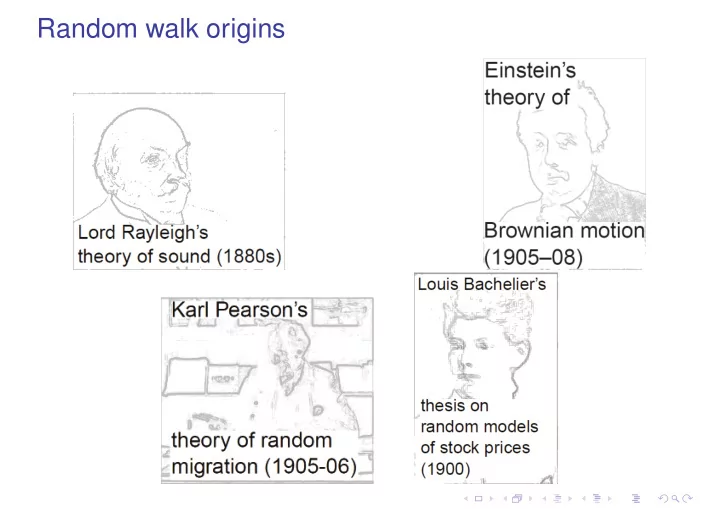

Random walk origins
Mathematical developments • While walking in a Zurich park in 1914, P´ olya encountered the same couple several times on his walk. • He asked: was this, after all, so unlikely? • Some time later P´ olya published his paper on an idealized version of the problem, now known as simple random walk (SRW). George P´ olya (1887–1985).
! ! ! ! ! ! ! ! ! ! ! ! ! ! ! ! ! ! ! ! ! ! ! ! ! ! ! ! ! ! ! ! ! ! ! ! ! ! ! ! ! ! ! ! ! ! ! ! Simple random walk A random walker on the d -dimensional integer lattice Z d . X n : position after n steps. At each step, the walker jumps to one of the 2 d neighbouring sites of the lattice, choosing uniformly at random from each. P´ olya’s question: What is the probability that the walker eventually returns to his starting point? Call it p d . p d = P [ X n = X 0 for some n ≥ 1 ] .
P´ olya’s question Simulation of 10 5 steps of SRW on Z 2 .
Recurrence and transience p d = P [ X n = X 0 for some n ≥ 1 ] . The random walk is transient if p d < 1 and recurrent if p d = 1. Theorem (P´ olya) Simple random walk on Z d is • recurrent for d = 1 or d = 2 ; • transient for d ≥ 3 . For example [McCrea & Whipple, Glasser & Zucker]: � √ � − 1 6 32 π 3 Γ( 1 24 )Γ( 5 24 )Γ( 7 24 )Γ( 11 p 3 = 1 − 24 ) ≈ 0 . 340537 .
Recurrence and transience Theorem (P´ olya) Simple random walk on Z d is • recurrent for d = 1 or d = 2 ; • transient for d ≥ 3 . Equivalently: • For d ∈ { 1 , 2 } , X n visits any finite set infinitely often. • On the other hand, if d ≥ 3, X n visits any finite set only finitely often. “A drunk man will find his way home, but a drunk bird may get lost forever.” —Shizuo Kakutani
! ! ! ! ! ! ! ! ! ! ! ! ! ! ! ! ! ! ! ! ! ! ! ! ! ! ! ! ! ! ! ! ! ! ! ! ! ! ! ! ! ! ! ! ! ! ! ! Probabilities and potentials Take two points in the lattice Z d , 0 and φ . Let p ( x ) = P [ SRW reaches φ before 0 starting from x ] . Then p ( 0 ) = 0 and p ( φ ) = 1. For x / ∈ { 0 , φ } , by conditioning on the first step of the walk, for which there are 2 d possibilities, p ( x ) = 1 � p ( y ) , x 2 d y ∼ x where sum over y ∼ x means φ 0 those y that are neighbours of x . Rearranging, we get � y ∼ x ( p ( y ) − p ( x )) = 0.
! ! ! ! ! ! ! ! ! ! ! ! ! ! ! ! ! ! ! ! ! ! ! ! ! ! ! ! ! ! ! ! ! ! ! ! ! ! ! ! ! ! ! ! ! ! ! ! Probabilities and potentials There is an equivalent formulation in terms of a resistor network. In the first instance, this makes sense on a finite subgraph A ⊂ Z d . Replace each edge of A with a 1 Ohm resistor. Ground the point 0 and attach a 1 Volt battery across 0 and φ . Let v ( x ) be the potential at point x . Then v ( 0 ) = 0 and v ( φ ) = 1. By x Kirchhoff’s laws, the net flow of current at x vanishes, and the flow across any edge is given by the potential difference, so φ 0 1 V � ( v ( y ) − v ( x )) = 0 . y ∼ x
Probabilities and potentials So both p and v solve the same boundary value problem � ( v ( y ) − v ( x )) = 0 y ∼ x with the same boundary conditions. The solutions are (discrete) harmonic functions. The connections to classical potential theory run deep. For example, one can study recurrence and transience: Theorem (Nash-Williams) The SRW on Z d is recurrent if and only if the effective resistance of the resistance network on A ⊂ Z d tends to ∞ as A → Z d .
Martingales and boundary value problems The effectiveness of this connection to potential theory relies on certain symmetry properties of SRW. In particular, SRW is both a Markov chain and a space-homogeneous martingale (which means that the walk has zero drift). The connection extends to a large class of processes in both discrete and continuous time. For example, the continuous-time, continuous-space analogue of SRW is Brownian motion. And in the continuous setting solving boundary value problems amounts to solving PDEs. The stochastic approach provides a powerful tool for studying PDEs, and has applications in e.g. • quantum theory; • mathematical finance; • etc.
Recommend
More recommend